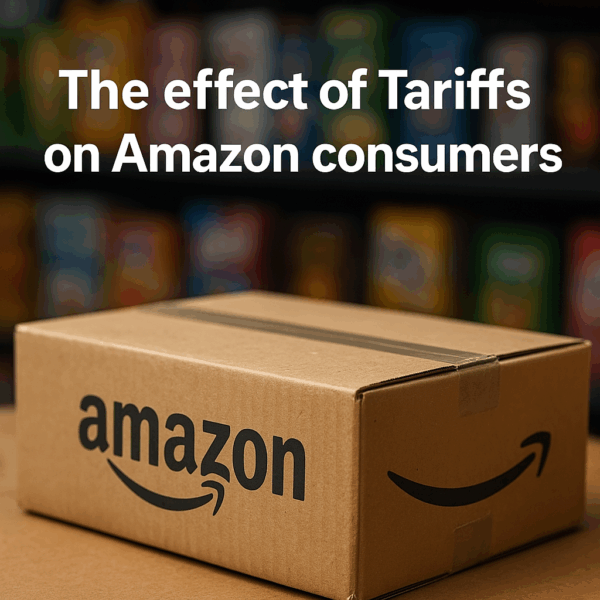Today, Amazon is the ideal platform for selling. One very clear reason why every seller needs to be on Amazon.com. Selling to a wide range of customers and having a diverse consumer base is now possible thanks to Amazon.
The sellers may reach a wider audience than ever before because of the more than 197 million customers who prefer Amazon over rival e-commerce websites. With this, there is insane competition among the sellers. The goal of every salesperson, whether they are novices or seasoned pros, is to increase sales and maximise earnings. One must perform well to defeat rivals. If they don’t, their products will be hidden in the search results, costing them clients.
Are you an Amazon seller who also feels that your rivals are stealing your customers? attempting to ascertain potential causes for it. If not, then that is OK. But if the answer is yes, you are in the right place. Today, we’ll discuss implementing a PPC campaign to outperform the competition and boost Amazon sales.
Let’s first examine how to promote on Amazon before going on to the techniques.
Amazon advertising is one of the most effective ways to increase sales. Amazon is considered to be the third most popular advertising platform because of this. You might be considering the greatest form of advertising at this point.
Utilizing an Amazon PPC campaign is the solution.
What is PPC on Amazon?
Pay-per-click advertising, often known as Amazon PPC, is an advertising approach in which the advertiser only pays the cost when a customer clicks on the advertisement. Amazon PPC ads enable Amazon sellers to raise brand awareness and enhance sales.
Through Amazon PPC product targeting techniques, one can steal sales.
PPC campaigns provide a technology known as “Amazon product targeting” that enables sellers to display their products on other Asin pages. One can position their products in line with other similar items in the marketplace by specifically targeting the other merchants. Increased visibility and authority may result from doing this.
A product’s brand awareness and exposure among customers can be increased by aligning it with established rivals, which can lead to higher sales and money.
The following actions must be taken to build a targeted marketing campaign:
Discovering the terrain is the first and most important step. Using the search tab, one must identify the item they wish to align with. The best-recommended search would be one that used a colour that matched the products.
The vendor can utilise software to target the ASIN after they are familiar with the products they wish to promote.
They must employ these carefully chosen ASINs in the following step. They need to start a new campaign here. In this campaign, the seller must choose the product they wish to feature in the advertisement from the product area. The list of ASINs from the export is then pasted in the “product targeting” section.
How to rank higher on Amazon than your rivals
You must identify, keep tabs on, and target your rivals if you want to succeed on Amazon. We’ll see how it functions.
1. Define your competitors
This can be challenging if there are more brands in your niche than you.
Consider that I wish to market a “flavoured organic green tea.” It might not be a good idea to launch a “medicinal black tea” product as a rival in such a case.
You must identify the best rivals to pursue. Therefore, it would be appropriate to filter them depending on:
- Price provided for features
- Number of created orders (sales)
- Ratings and reviews
This aids in obtaining your direct rivals who have comparable clientele.
2. Protect your brand
Brand terms should be included in keyword research so that you are informed when a brand defence strategy is required. While brand targeting is unlikely to result in significant growth in sales volume, losing market share on brand terms to rivals means letting them steal your money.
Keep track of the performance of any keywords connected to your brand. You might be dealing with a competitor that has just started targeting your brand terms if performance on any of those brand terms starts to drop or you notice a decline in your product ranking.
By separating your brand’s keywords into their campaign or ad group and increasing spending on those terms, you can defend your brand coverage. Because you’ll want to divide your expenditure differently, it’s a good idea for well-known businesses on Amazon to keep brand terms apart from generic or rival searches.
You may regain some of the share of voice that your rivals are attempting to take away from you by spending more on your brand terms.
3. Target Your Competitors
You may determine which search terms your competitors are outperforming you on by monitoring their performance on those terms. Identify the areas where your rivals are succeeding and boost your spending on those keywords to overtake them.
Going after the winning items rather than the keywords is another method to target your rivals. To encourage customers to choose your product over competing ASINs, use Product Attribute Targeting (PAT).
Consider what would make a customer choose your product instead of another when using PAT targeting. Targeting comparable products with fewer ratings, a higher price tag, or visibly fewer features is a good idea.
It’s a chance to learn from your rivals as well if these tactics don’t help you rank higher or if you evaluate the possibilities for PAT campaigns and find that your rivals are offering a better deal. For suggestions on how to enhance your offering, look at their product positioning and how they fill out their product information page.
4. Track Prices
You cannot ignore this factor. On every platform or channel, it is always crucial, but in the case of Amazon, it is especially crucial. It directly affects how likely we are to land in the desired buy box.
The double track once more. We can manually check the chosen products and make spreadsheet updates. Because it is not very productive, I would not advise doing this.
Depending on what you ask for, there are several tools to achieve it automatically. Repricing tools exist that can control price changes based on rivals’ tactics.
5. Find out how your rivals sell their goods
A customer’s decision to buy can be heavily influenced by the branding and marketing of your items and those of your competitors. The tone of the listing description, the product photos, the packaging design, the A+ content, and how the brand interacts with its audience all play a role in this.
Check out their social media presence and other non-Amazon marketing initiatives as well. The impact of social media on brand recognition and e-commerce is significant. More than half of shoppers have bought products they learned about on social media.
6. Take Advantage of Amazon Reviews and Ratings
When buying a product, consumers look for reliable information, and reviews are their go-to resource for finding real insights about the item.
You may learn three things about your target market and competition by examining Amazon reviews and ratings.
- Can you make your product superior to that of your rivals?
- Does the product have enough demand?
- How to increase brand awareness by focusing on the right consumer persona
1. Can you make your product superior to that of your rivals?
Several of our clients’ products go through this procedure, particularly niche products and CPGs (Consumer Packaged Goods). Look through the pros and cons of evaluations left by rival companies that provide identical products. Long-term, this will provide insights that will enable you to improve your product’s features and functionality in light of user feedback.
You can also draw attention to features that can address issues that customers had with the products of your rivals.
2. Does the product have enough demand?
For larger brands or a new seller looking to debut a product, this is a crucial consideration. You can determine how popular a product is on Amazon by looking at the number of reviews and how actively customers participate in the reviews.
3. How to increase brand awareness by focusing on the right consumer persona
Let me explain why this can be challenging.
The mindset of the consumer varies from product to product. For instance, a customer purchasing a premium item like a Rolex watch is more interested in the product’s elegance and appearance than its price. On the other hand, another consumer who wants to get a towel will think about if the item is worthwhile. To reach your chosen target group, you must project your brand in the right way. One of the simplest methods to fascinate your customers is using Amazon A+ content.
7. Throughout their buying cycle, target consumers
How we reach more people on a tight budget is a common question from our businesses.
Well, the solution is to create accurate listings.
I’ve always observed that brands, in particular, get fixated on employing high-volume or branded keywords by sellers. They are reducing their customer base at this point. When a person is considering purchasing a product, their searches start general and get more focused as they approach closer to doing so.
For instance, a person would type “running shoes” into the search bar on Amazon to look for running shoes. He inputs search terms like “running shoes for guys,” “running shoes for hard surfaces,” and “running shoe combo” as he selects what kind of shoes he wants to buy.
Thus, for conversions, long-tail keywords are your best bet. Consider including them in your product listings.
8. Conduct Back-Keyword Research
It could be a little challenging at first, but you should try this exercise. Additionally, it is advisable to strive to get a reflection of the keyword research of each rival as well as an overall one if you want to conduct a genuinely accurate study of your competitors on Amazon.
You can easily locate the terms on which people concentrate the spotlight among all the components of the previous point (titles, descriptions, reviews, etc.), but other less labour-intensive methods can also be helpful.
You can search using an ASIN or keywords with several browser add-ons and programmes. We entered the term “body pillow” in the browser search bar and chose the US market to demonstrate how it functions. We will have up to 5009 options in a moment. You must complete the checkout to view all the results, however, we’ve provided a sampling of some of the more pertinent ones, including:
- A neck pillow
- Cover for a body pillow
- A pregnancy body cushion
- Pregnancy body pillow
And even others that don’t directly derive but stand for ideas we should incorporate into our listing texts and advertising strategies. In this instance
- Whole-body
- Case for a pillow
- Formed body
- Body foam
From this point on, we will have a clearer understanding of how they operate. By comparing this keyword research with our own, we may determine which words we have in common but disagree with, which words are uniquely ours, and which ones they use but we do not.
Then, we can start working on optimising our listings for both our advertising strategy and organic positioning.
Conclusion
I always keep a watch on the listing quality scores of my rivals, but beating them in the organic ranks is not enough. To beat my rivals organically and provide a better alternative when attacking their listings using Product Targeting Ads on Sponsored Products, I prefer to keep an eye on their pricing both inside and outside of Amazon and, in particular, track any reductions in ranking.
The stock of your rivals is another essential thing to watch. It’s time to attack them with Sponsored Products PAT and their branded keywords on Sponsored Brands / Products + the backend keywords if they run out of stock or are ready to do so.
At the end of the day, Amazon wants to see purchases generated by keywords from prospective buyers. Consequently, you must become an expert in keyword research.


